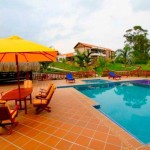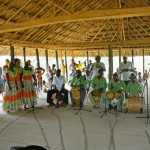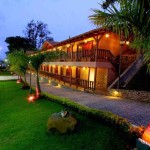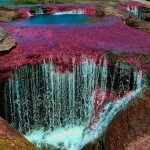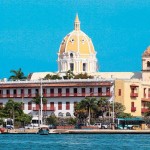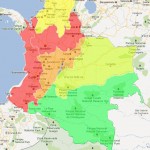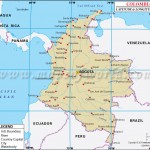Colombians customarily describe their country in terms of the climatic zones. Below 1,000 meters (3,281 ft) in elevation is hot land (the tierra caliente), where temperatures are above 24 °C (75.2 °F). About 82.5% of the country’s total area lies in hot land
The Climate of Colombia is characterized for being tropical and isothermal as a result of its geographical location near the Equator presenting variations within five natural regions and depending on the altitude, temperature, humidity, winds and rainfall. Each region maintains an average temperature throughout the year only presenting variables determined by precipitation during a rainy season caused by the Intertropical Convergence Zone.
Climate Zones
The diversity of climates in Colombia is characterized for having tropical rainforests, savannas, steppes, deserts and mountain climate, this last one further subdivided into tierra caliente (hot land) tierra templada (temperate land) tierra fría (cold land), tierra helada (frozen land) and Páramo. But sometimes the weather of Colombia is altered by the seasons in northern hemisphere, for example from March to June the weather is mild Spring, from June to August the weather is hot Summer, From September to December the weather is cold Autumn, and from December to March the weather is even colder Winter.
Climate Zones
The tropical rainforest climate is characterized by hot and high humidity climate along with heavy rainfall mostly present in the jungles of the Catatumbo, the Amazon river basin the central region of the Magdalena River, the Pacific coast, the Serranía del Perijá and others.
Tropical savanna
This is the typical climate of the Eastern Plains and Caribbean coasts. The tropical savanna has rainy and dry times (6 months each) and an average temperature above 24°C.
Tropical Steppe
This climate has little rainfall, and it is typical of the Eastern Plains and savannahs of Bolivar and the northern Guajira.
Tropical desert

La Tatacoa Desert: a garden turned desert – Tourism in Colombia
With temperatures over 29°C, this climate is typical of the high Guajira. This is the less rainy region of Colombia.
Tropical mountain climate
Mountain climate is one of the unique features of the Andes, the Sierra Nevada de Santa Marta and other high altitude reliefs where climate is determined by elevation. (Spanish: Pisos termicos), a classification used in some countries but with variations in the classification of each floor.
Common to the Andes and the Sierra Nevada de Santa Marta, this type of climate is determined by elevation, defined as thermal floors…
– between sea level and 1.000 m.a.s.l. – Similar to the equatorial and tropical plain, temperatures can reach over 29 °C (84.2 °F).
– 1.000 to 2.000 m.a.s.l. – The temperature drops oscillating between 17 and 22 °C (62.6 and 71.6 °F).
– 2.000 to 3.000 m.a.s.l. – With average temperature ranging between 10 and 17 °C (50.0 and 62.6 °F).
– 3.000 to 4.000 m.a.s.l. – Temperature in this thermal floor is lower than 10 °C (50 °F).
– 4.000 meters up – With severe weather and average temperatures ranging between 10 °C (50 °F) and less.
Mountain climate is one of the unique features of the Andes, the Sierra Nevada de Santa Marta and other high altitude reliefs where climate is determined by elevation. (Spanish: Pisos termicos), a classification used in some countries but with variations in the classification of each floor.
Warm climate altitudinal zone
The warm altitudinal zone oscillates between sea level and 1,000 meters (3,281 ft) above sea level with a temperature over 24 °C (75.2 °F). Climate in this step is characterized for its similarities with the equatorial and tropical plains, heavy rains and high temperatures. Temperatures can reach over 29 °C (84.2 °F) as it is the case of the Magdalena river valley, which has many areas with jungles. This altitudinal zone is present in the cities like Santa Marta, Neiva, Cali and Cúcuta.
Temperate climate altitudinal zone
Between 1,000 and 2,000 meters (3,281 and 6,562 ft) above sea level the temperature drops oscillating between 17 and 22 °C (62.6 and 71.6 °F) defining it as a temperate climate. Rainfall becomes variable at 1,700 meters (5,577 ft) above sea level and rains between 2,000 and 2,500 mm (78.7 and 98.4 in) . This climate is a characteristic in the cities like Pereira, Armenia, Ibagué Popayán and Medellín.
Cold climate altitudinal zone
The cold climate is present between 2,000 and 3,000 meters (6,562 and 9,843 ft) above sea level and is characterized for having Andean or cloud forests. This altitudinal zone is characterized for presenting an average temperature ranging between 10 and 17 °C (50.0 and 62.6 °F) while rainfall reaches a yearly average of 2,000 mm (78.7 in). The Colombian capital city Bogotá is located within this altitudinal zone. Other cities like San Juan de Pasto and Tunja are in this location.
Páramo climate altitudinal zone
The Páramo climate is present between 3,000 and 4,000 meters (9,843 and 13,123 ft) above sea level and the temperature is lower than 10 °C (50 °F) with icy winds, rare rainfall but frequent snowfall. Colombia has one of the largest páramo areas in the world; the Sumapaz Páramo located in central Colombia, over the Andean Cordillera Oriental branch. In Colombia páramos are further classified as subpáramo, páramo and superpáramo. Most of the rivers in Colombia are born here since páramos tend to hold water from precipitations and deglaciations coming from the peaks.
Glacial climate altitudinal zone
The glaciers in Colombia are located at 4,000 meters (13,123 ft) above sea level and up and with average temperatures ranging between 10 °C (50 °F) and less. Glaciers in Colombia began retreating in the 20th century due to global warming and are in danger of disappearing, if this occurs water supply would be scarce in the near future.[6][7] Most of the glaciers are located in the Andes mountains and are inhabited by very few living species due to its severe weather.
Tours & Tickets in Colombia
| COLOMBIA TRAVEL GUIDE |
| Related Articles |
If you’re travelling to Colombia, we help you:

![]() General Information About Colombia: National symbols of Colombia – Colombia: living history – Geography of Colombia – Economy of Colombia – Languages of Colombia
General Information About Colombia: National symbols of Colombia – Colombia: living history – Geography of Colombia – Economy of Colombia – Languages of Colombia
![]() Practical information about Colombia: Climate – How to get to Colombia – Visa, Customs, Documentation and Taxes – Embassies and consulates in Colombia – Health and vaccination – Emergency numbers – Culture of Colombia – Measures and Electricity – Currency of Colombia
Practical information about Colombia: Climate – How to get to Colombia – Visa, Customs, Documentation and Taxes – Embassies and consulates in Colombia – Health and vaccination – Emergency numbers – Culture of Colombia – Measures and Electricity – Currency of Colombia
![]() Tourist Information about Colombia: General Information – Practical information about Colombia – Adventure Colombia – Hotels and accommodations in Colombia – How to Get to Colombia – Gastronomy in Colombia – Colombia’s Best Festivals and Carnivals – Tourist Attractions in Colombia – Foreign Embassies and Consulates in Colombia – Tips and advice for travel in Colombia – Top 10 Colombian Travel Destinations – Natural regions of Colombia – Cultural Tourism in Colombia – UNESCO Intangible Cultural Heritage Lists – UNESCO Heritage Sites in Colombia – Top 10 amazing places to visit in Colombia – Colombian Cuisine – Tourism of Nature
Tourist Information about Colombia: General Information – Practical information about Colombia – Adventure Colombia – Hotels and accommodations in Colombia – How to Get to Colombia – Gastronomy in Colombia – Colombia’s Best Festivals and Carnivals – Tourist Attractions in Colombia – Foreign Embassies and Consulates in Colombia – Tips and advice for travel in Colombia – Top 10 Colombian Travel Destinations – Natural regions of Colombia – Cultural Tourism in Colombia – UNESCO Intangible Cultural Heritage Lists – UNESCO Heritage Sites in Colombia – Top 10 amazing places to visit in Colombia – Colombian Cuisine – Tourism of Nature
![]() Travel Guide of Colombia: Colombia Travel Guide – Amazonas – Antioquia – Arauca – Atlántico – Bolivar – Boyacá – Caldas – Caquetá – Casanare – Cauca – Cesar – Chocó – Córdoba – Cundinamarca – Guanía – Guaviare – Huila – La Guajira – Magdalena – Meta – Nariño – Norte de Santander – Putumayo – Quindio – Risaralda – San Andrés y Providencia – Santander – Sucre – Tolima – Valle del Cauca – Vaupés – Vichada
Travel Guide of Colombia: Colombia Travel Guide – Amazonas – Antioquia – Arauca – Atlántico – Bolivar – Boyacá – Caldas – Caquetá – Casanare – Cauca – Cesar – Chocó – Córdoba – Cundinamarca – Guanía – Guaviare – Huila – La Guajira – Magdalena – Meta – Nariño – Norte de Santander – Putumayo – Quindio – Risaralda – San Andrés y Providencia – Santander – Sucre – Tolima – Valle del Cauca – Vaupés – Vichada
Flights, Cheap Airfare Deals & Plane Tickets |







